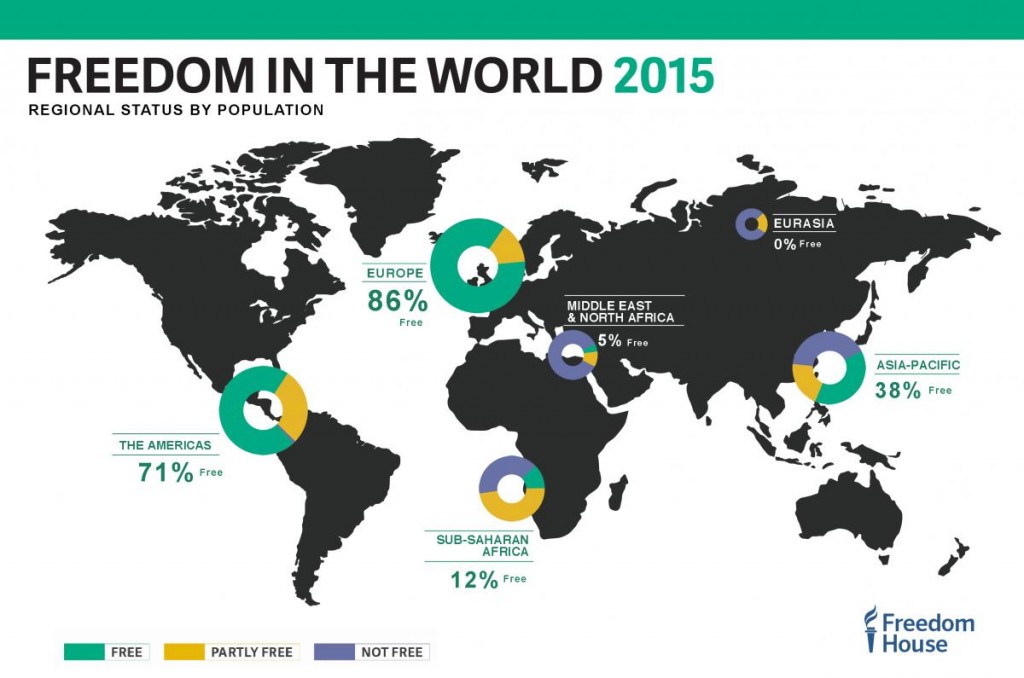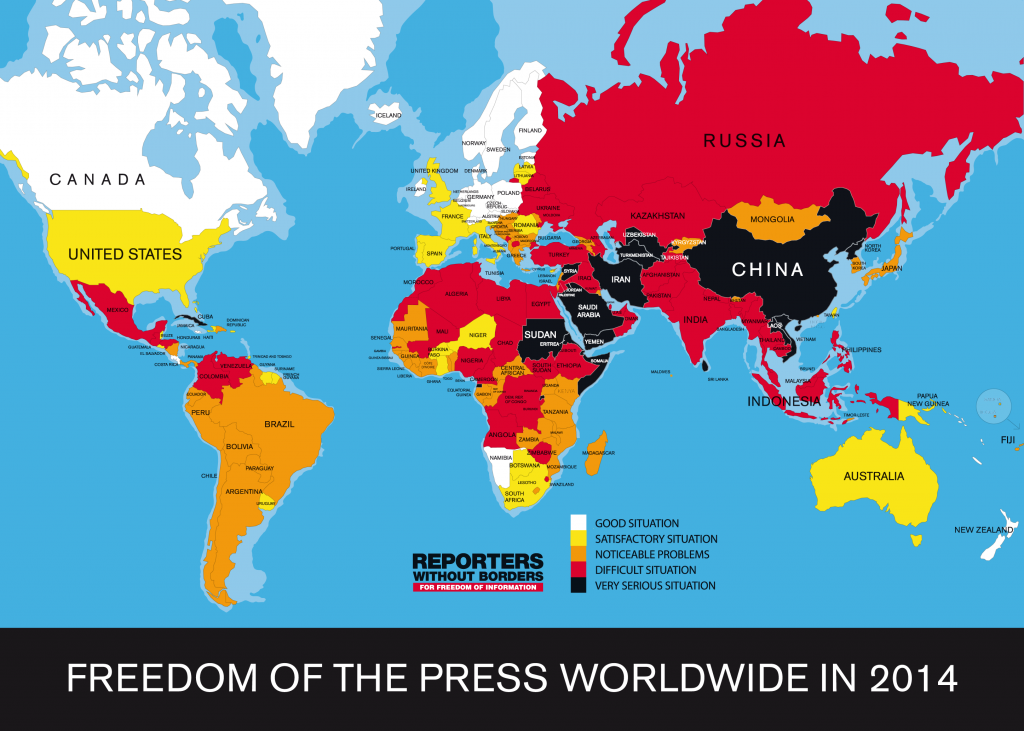Marlowsphere Blog (#117)
Freedom House—an organization founded in 1941 by former first lady Eleanor Roosevelt and attorney Wendell Willkie—has published its latest report on “Freedom in the World 2015.” It is not a pretty picture.
While the second half of the 20th century witnessed the growth of freedom in the world, in the late 20th century (starting in 1995) until now, human rights freedoms, country by country, has declined on a global basis. The kind view is that the growth of freedom has at least stagnated. To quote from the report:
More aggressive tactics by authoritarian regimes and an upsurge in terrorist attacks contributed to a disturbing decline in global freedom in 2014. Freedom in the World 2015 found an overall drop in freedom for the ninth consecutive year.
Nearly twice as many countries suffered declines as registered gains—61 to 33—and the number of countries with improvements hit its lowest point since the nine-year erosion began. Russia’s invasion of Ukraine, a rollback of democratic gains by Egyptian president Abdel Fattah el-Sisi, Turkish President Recep Tayyip Erdoğan’s intensified campaign against press freedom and civil society, and further centralization of authority in China were evidence of a growing disdain for democratic standards that was found in nearly all regions of the world.
The worst regions of the world with respect to lack of freedom are Northern Africa and the Middle East.
The decline (or stagnation) in human rights freedoms reported by Freedom House parallels the ranking of world countries with respect to journalistic freedom of the press. According to Reporters Without Borders (RSF) “World Press Freedom Index 2015″:
Two-thirds of the 180 countries surveyed for the 2015 World Press Freedom Index performed less well than in the previous year,” the France-based watchdog said. RSF attributed the decline largely to attacks on media as global conflicts proliferated throughout 2014. This includes not only repressive regimes, but also non-state groups such as Boko Haram and Islamic State, which “used fear and reprisals to silence journalists”.
Iran, China, Syria and North Korea were among the places ranked as having the worst levels of press freedom. China came in 176th, one step down from last year.
. . . .Around the world, France ranked 38th (up one place) the U.S. 49th (down three places) and Russia 152nd (down four).
This blog has already pointed to the issue of the relationship between lack of literacy (or to put it another way, levels of illiteracy) and violence. The general conclusion is that where there’s significant levels of illiteracy (such as in Pakistan), there’s significant levels of violence, especially against girls and women. Further, where’s there’s significant levels of illiteracy (such as in Egypt), there’s significant lack of human rights freedoms.
But there’s another relationship that bears mentioning, and that is the relationship among levels of human rights freedoms (or the lack thereof), media ownership, and distribution of wealth.
 The question is this: is there a relationship—that has evolved over the last 30-35 years—among the very real stagnation of growth of human rights freedoms in the world, the very real consolidation of media ownership on a global basis, and the very real high levels of wealth concentration on a global basis?
The question is this: is there a relationship—that has evolved over the last 30-35 years—among the very real stagnation of growth of human rights freedoms in the world, the very real consolidation of media ownership on a global basis, and the very real high levels of wealth concentration on a global basis?
To provide some detail, in the last 30-35 years corporate ownership of media assets—print and electronic—has shrunk from about 80 companies to a mere handful. Depending on one’s definition, the major players in the media ownership industry range from a mere six to (perhaps) 12. The major players are such companies as: Disney, Bertelsman, Sony, COMCAST, News Corp., Time-Warner, CBS, et al.
During this same time period, the rich have gotten richer, the poor have gotten poorer, and the middle class has stagnated. A recent report pointed out that 80 people in the world had as much combined wealth as 3 ½ billion people on the planet. With respect to the latter group, the reference is to the poorest people on planet Earth.
Granted, the 20th century has seen staggering rates of transportation, information, and communications technological innovation, literacy rates globally have risen significantly (according to UNESCO), healthcare has improved for more and more people globally, and in some parts of the world (China, for example, which is an irony), the middle class has grown dramatically, i.e., since Mao’s demise in 1976 several hundred million people have been brought out of poverty into the middle class.
Yet, in the same time period, the level of terrorism on a global scale has increased, fewer and fewer companies own more and more media assets, fewer and fewer people own more and more real and financial assets, and the growth of human rights freedoms has stagnated.
There was a time when the Internet was viewed as the technology that “would level the playing field for small vs. large companies.” To a degree this is true, but the fact of the matter is that large companies still own major portions of the playing field. The financial crisis of 2008-2009 in the United States—that had global repercussions—shuttered one major financial institution, Lehman Brothers, and a host of much smaller firms, not to mention the thousands of individuals who lost their homes; but the rest—those that were too big to fail—were saved by the tax payer!
It would be naïve to conclude that only financial institutions are the ones to point to for our current spate of global financial and geo-political problems. There are other reasons. One is the deeply imbedded clinging to outmoded beliefs and extreme religious concepts in certain parts of the world among certain communities. These communities are angered by the accelerating cultural changes brought on by technology and are reacting violently.
 Another reason is the disruption of technology to cultural mores and norms in certain parts of the world. In general, people don’t like change. They want stability. Regardless, technological innovation brings about disruption to cultural mores and norms. In turn, external change challenges a culture’s world perspective. It’s hard to make the adjustment or give up perceptions that don’t work anymore. A good read on this subject is The Structure of Scientific Revolutions by Thomas Khun. The concepts in this book can be applied to the individual, the family, the larger community, and the country.
Another reason is the disruption of technology to cultural mores and norms in certain parts of the world. In general, people don’t like change. They want stability. Regardless, technological innovation brings about disruption to cultural mores and norms. In turn, external change challenges a culture’s world perspective. It’s hard to make the adjustment or give up perceptions that don’t work anymore. A good read on this subject is The Structure of Scientific Revolutions by Thomas Khun. The concepts in this book can be applied to the individual, the family, the larger community, and the country.
The question then becomes: does the inexorable march of technological innovation create opportunities for a few to grab wealth and political power to the detriment of the rest of the populace? Is there, indeed, a close (perhaps, inevitable) relationship among the stagnation of growth of human rights freedoms, media consolidation, and wealth concentration among a few in the last 30-35 years?
It cannot be mere coincidence.
If you have any questions or comments about this or any other of my blogs, please write to me at meiienterprises@aol.com.
Eugene Marlow, Ph.D.
February 16, 2015
© Eugene Marlow 2015



